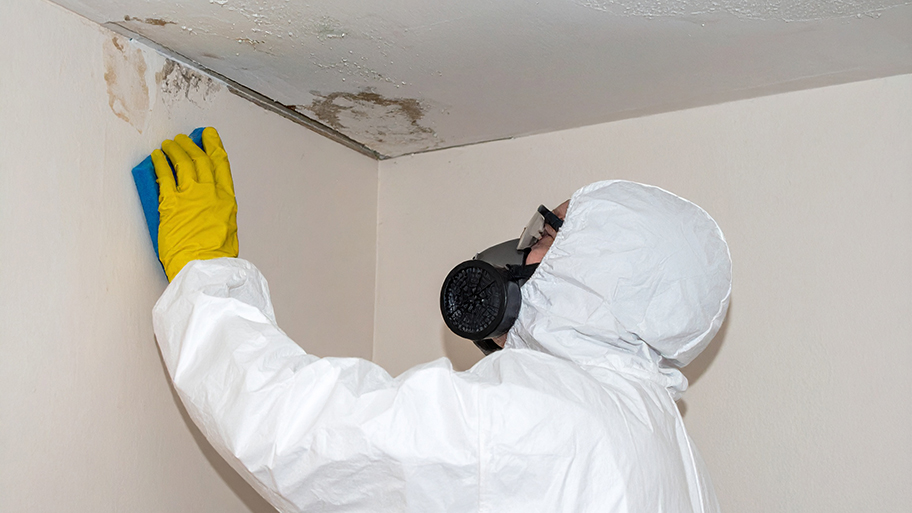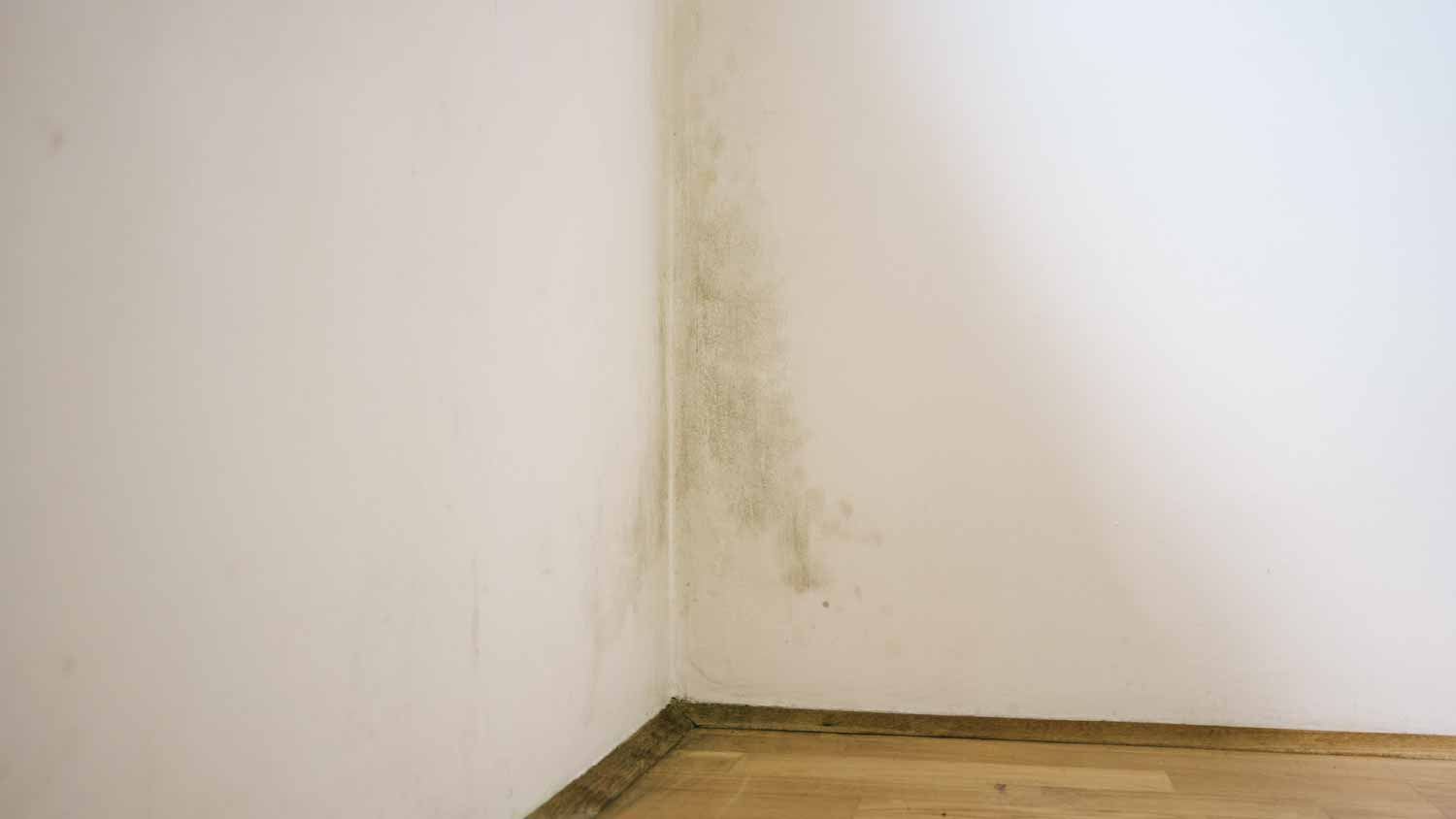
Mold remediation cost can quickly escalate. But if you have mold in your home, the cost for mold remediation is worth it.
Remediating mold in your home is often less scary than it sounds


Any signs of mold may require remediation techniques.
Damp and musty odors are key indicators of mold.
Mold can be almost any color and have various textures.
Costs for remediation are lower the sooner you spot the mold.
Hire a mold inspector before seeking help from remediation pros.
Mold can grow in a house because of flooding or leaks, or in damp, humid spaces hidden from view. If you see mold and wonder when mold remediation is required from a pro, the Environmental Protection Agency (EPA) recommends hiring a pro for any contaminated space that is greater than about 10 square feet. When is mold remediation required? Learn how to determine if you need mold remediation, then learn what to do to banish it from your home for good.
Recognizing early warning signs is important, but figuring out the right fix isn't always simple. Delaying professional help or attempting complex DIY repairs can lead to further damage and increased costs. With our network of local pros, you can hire a skilled professional to assess the issue and recommend the best solution.
When do you need mold remediation? Beyond appearance, here are some indications that you could be dealing with mold in your home.
Not all mold will give off a musty or pungent odor, but many do. Your first sign that you may need mold remediation could be a smell that comes and goes. Mold thrives in dark, humid places: think attics, basements, bathrooms, and under sinks. Inspect these areas for mold if you catch a whiff of something unpleasant, musty, or—you guessed it—moldy.
At times, you may smell a musty smell, but cannot find any signs of mold–or the exact origin of the odor. This could indicate that mold is growing behind a wall, or another area that you cannot easily access. If the musty odor seems stronger near wall outlets, this could indicate mold behind the wall, and the odor is traveling through the holes in the outlet.
Don’t ignore this odor. The longer you leave the mold growth unchecked, the more it will cost to fix it later and the more potential health issues you may experience.
If you suspect mold in your home, contact a local mold removal company, who can tell you if you need to have your home treated.
If you can smell the odor and you can’t see it, usually that is a sign of something more serious. Mold can hide behind your walls and floors and will require a professional mold remediation company to run indoor air quality tests.
You may see signs of condensation inside your home on windows or walls when warm air from inside the home comes in contact with surfaces that have cold air from outside on the opposite side. You may notice condensation on air ducts and HVAC units, too.
Condensation can involve more water buildup than you may realize is occurring. It then may run down a wall or pane of glass, collecting behind baseboards or window molding. Eventually, this dampness can serve as a spark for mold to grow.
If you have a lot of condensation anywhere in your home, this is a good starting point to hunt for a potential infestation that may require mold remediation. To prevent condensation, you may want to insulate these areas or run a dehumidifier nearby.
Anytime your home floods or you locate a water leak, it’s a good idea to check for mold in the affected areas. The presence of water doesn’t necessarily mean there is mold, but because mold spores are so tiny, it can be hard to tell if mold is growing with the naked eye.
Catching mold early helps to lower the overall damage and remediation cost, so consider paying for a mold inspection after a flood or major water leak as a precautionary measure.
Carpet and area rugs, which hold on to dust and dirt, can be breeding grounds for mold if they get wet and are not dried quickly and adequately. You can avoid carpet mold after water damage, but it requires a lot of elbow grease and scrubbing.
As mentioned above, just like when you find a funky loaf of green bread in the back of the pantry, mold in your home can show up in various colors that resemble speckles, fuzzy spots, filmy spots, or circular rings, including:
Black
Green
Pink
Orange
White
Yellow
Red
Dark brown
Gray-brown
Gray-green
As you can see, mold comes in a lot of colors, which complicates the process of diagnosing it. Basically, anytime you see a change in color on any surface, including cabinets or walls, do a mold check. If you do find mold, you should also check your air ducts to see if mold is growing there. Contact a local professional to help you take care of it correctly.
Not everyone will experience health effects when exposed to mold, but according to the Centers for Disease Control and Prevention (CDC), individuals who are sensitive to it may have symptoms, including wheezing, red eyes, a stuffy nose, and itchy eyes or skin.
Even when you don’t see actual mold on walls, you could still have an exposure to mold that makes you feel ill. If the mold is hiding inside your air vents or HVAC system, the mold spores may travel throughout your home as the air moves. Inhaling these spores can leave you with respiratory issues related to mold exposure. A mold inspection should always involve checking the air ducts.
Unfortunately, there’s no health test from the doctor to determine mold exposure. The best way to sleuth out mold reactions is to track whether symptoms go away when people leave the house. If so, it’s worth a hard look to see if mold is lurking.

It’s tempting to call any spore or icky buildup in your home “mold,” but identifying it can be tricky. Mold typically builds up in damp areas, like in your bathroom or basement, or at the sources of a water leak, but can show up anywhere that moisture lives.
Mold will usually start appearing in the form of fuzzy white spots and can eventually look green, blue, gray, orange, black, or a few other colors. You may even mistake the spots for stains at first, but if these stains grow and start to smell musty, you’re likely dealing with mold. (Side note, that’s why it’s so important to deal with mold ASAP.)
You may have also heard the term “mildew,” which is a type of mold. It tends to look dry and shows up as white, yellow, or gray spots. The good news is that you can deal with both in similar ways: staving off moisture and cleaning up the area with a cleaner appropriate for the surface in question.
Mold remediation is the process of identifying, removing, and preventing the spread of mold growth in indoor environments. It begins with a thorough inspection and testing to assess the extent of the mold problem and its underlying causes.
Once identified, containment measures, like sealing off affected areas, prevent mold spores from spreading during cleanup. Professionals then use specialized equipment to remove mold colonies, clean contaminated surfaces, and dispose of materials that can’t be salvaged, such as damaged drywall or carpeting. The area is then treated with antimicrobial solutions to kill any remaining mold spores.
The final step of the mold remediation process addresses the root cause of mold growth, such as fixing leaks or improving ventilation—ensuring long-term prevention. Mold remediation restores a safe and healthy living environment and protects your property from further damage.
One of the reasons you may have concerns when mold remediation is required is because of the potential cost to fix it. The good news is that experts can fix the problem, perhaps for a lower price than you may think, especially if you call them early before the mold has a chance to spread significantly.
A typical mold remediation cost is between $1,100 and $3,300. The size of the infestation, the location of the mold, and the items that need repair all affect the potential cost. But before you start fretting about costs, note that some home insurance policies will cover mold remediation costs.
Always start with an inspection. A typical mold inspection cost is between $300 and $1,000. Beyond just looking for signs of mold, inspectors will do things like test your air quality, test your HVAC system and air ducts, and look for causes of condensation and moisture leaks that lead to mold formation. This is a thorough inspection that seeks active mold as well as conditions that lead to mold.
Although you may have a temptation to hire the same company to find and fix the problem, hiring separate people for mold testing and remediation often works better. This simply prevents any conflict of interest when searching for the mold.
The EPA recommends following these 10 steps to keep mold from growing in your home:
Dry damp areas: Use a fan after a significant water leak or flooding to try to dry out the damp area as quickly as possible.
Use a dehumidifier: In areas where you notice condensation, place a dehumidifier nearby to reduce dampness and to keep humidity levels below 50%.
Clean HVAC system: If your air conditioner uses a drip pan or a drain hose to move water that collects in the unit, keep these items clean and in good working order.
Fix condensation issues: If you notice condensation on windows or walls, take steps to fix the cause as quickly as possible, usually through adding insulative material.
Insulate pipes and fix leaks: Don’t let leaky pipes introduce extra moisture into your home’s humidity levels. If your cold water pipes often sweat, insulate them.
Run your air conditioner everywhere: Although you may turn off your AC unit or block vents in some areas of the home to try to save money, you could leave too much humidity in the air in those areas. Allow the AC unit to move at least some air into all areas of your home.
Encourage airflow: Leave doors open as much as possible to allow airflow throughout the house.
Run an exhaust fan in the bathroom: Having a working exhaust fan in the bathroom helps to pull humidity out of the air when taking a shower.
Protect the foundation from water: Keep your gutters clean and keep downspouts attached. Make sure rainwater flows away from the foundation. Having less water near your foundation keeps interior humidity levels lower and prevents seepage through concrete blocks of the foundation.
Fix a leaky roof: Water that leaks through holes in the roof could end up behind your walls, eventually leading to a mold infestation in an area where you cannot see it.
From average costs to expert advice, get all the answers you need to get your job done.

Mold remediation cost can quickly escalate. But if you have mold in your home, the cost for mold remediation is worth it.

The cost of a mold inspection might seem high, but it’s one of the best investments you can make for your health and home. Read on to learn cost-saving tips.

There's an excellent reason why you should avoid going with the same company for mold testing and mold remediation. Learn why different companies should handle these tasks.

Mold infestations can negatively impact your health and home resale value. Read on to determine if mold will create issues for your home and how to resolve them.

Mold is a serious health hazard and, unfortunately, difficult to detect in your home. Use this guide to help determine if hidden mold is making you sick.

Worried about mold behind your drywall? Learn how to spot the signs and when it’s time to call in a professional, plus how to prevent it in the future.